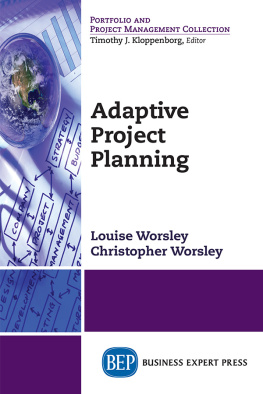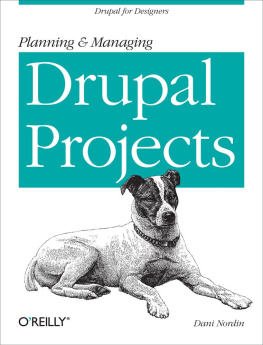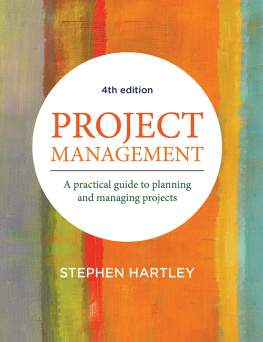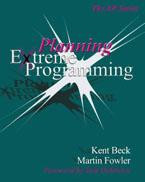
Adaptive Project Planning
Adaptive Project Planning
Louise Worsley and Christopher Worsley

Adaptive Project Planning
Copyright Business Expert Press, LLC, 2019.
All rights reserved. No part of this publication may be reproduced, stored in a retrieval system, or transmitted in any form or by any meanselectronic, mechanical, photocopy, recording, or any other except for brief quotations, not to exceed 400 words, without the prior permission of the publisher.
First published in 2019 by
Business Expert Press, LLC
222 East 46th Street, New York, NY 10017
www.businessexpertpress.com
ISBN-13: 978-1-94944-399-8 (paperback)
ISBN-13: 978-1-94999-100-0 (e-book)
Business Expert Press Portfolio and Project Management Collection
Collection ISSN: 2156-8189 (print)
Collection ISSN: 2156-8200 (electronic)
Cover and interior design by Exeter Premedia Services Private Ltd., Chennai, India
First edition: 2019
10 9 8 7 6 5 4 3 2 1
Printed in the United States of America.
Abstract
Projects are different. To be successful, they must meet the conditions defined by the projects stakeholders. Sometimes these conditions are explicit: it must be finished by this date, it cannot exceed this budget. Sometimes they are more subtle: the outputs, or the outcomes, must meet specificoften poorly articulatedcriteria. The consequence is that the context, not the scope, of the project, is the real shaper of what has to be achieved, how it has to be done, and when. There is no pre-trodden path. To deal with this uniqueness and the uncertainty it gives rise to, project managers have to plan.
Despite claims to the contrary, there is no single approach to planning a project, but for a given set of circumstances, there is a best one. This book takes you through many common planning situations you will meet. It uses stories of real projects to show how planning decisions alter depending on the project context. It discusses how resource- constrained planning differs from end-date schedule planning. It looks at what is different between cost-constrained plans and time boxing. It explores why you must plan when using Agile approaches, and how to plan for innovation.
Keywords
adaptive planning; Agile; project constraints; project management; project planning; resource modeling; scheduling; scope management
Contents
Appropriate planning of a project is the hallmark of a professional project managergood planning is what sets apart great projects from accidents. It is what ensures that the executive actions undertaken remain connected to the goals and outcomes expected by the stakeholders. A project plan is a framework for decision making throughout the life of the project. It is hardly surprising then that the significance of planning in projects is much greater than in any other management discipline.
Today if you ask a project manager what the most important skill they require for their job is, they are likely to refer to areas such as stakeholder management, communications, leadership, or behavioral competencies. Is this because it is assumed that planning is obviously important and does not need to be mentioned or is it that project managers believe that with the right leadership style, communications and engagement they dont need planning? Do approaches such as Agile, which expound people over process, deliberately or inadvertently promote the obsolescence of planning?
After more than 70 years of experience in project management, and working with hundreds of professional, high-performance project managers, we know planning in projects is essential, but have also found the planning discipline to be both underused and misunderstood. Three factors we believe are responsible.
- Planning is tricky to teach and to learn . Methods and frameworks such as PMI and PRINCE2 discuss processes involved in planning, but neither gives real insights into what a good plan is and what proper planning feels like. The purpose of the planning process is to structure the controllable factors to make the project achievable within the set of success conditions (constraints and critical success factors).
- Planning is confused with scheduling . We do sometimes wonder if this is deliberate! We note the frequent and common substituting of the one word for the other, and the way sponsors accept Gantt charts when they ask for the project plan. Microsoft Project may or may not be a useful scheduling tool. What it most certainly is not, is a planning tool. What is so saddening is that while every project benefits from having a plan, it is less evident that all need a schedule, and many that have one dont follow it.
- Templates are introduced to standardize and simplify planning . Possibly, in a well-intentioned effort to ease the learning curve for junior project managers and inexperienced sponsors, project management offices provide, promulgate, and sometimes mandate the use of a planning template. While without a doubt there is a single idea behind the need for a project plan, the impact of the differing contexts of projects frustrates the ambition for a single silver bullet template.
In our research into what makes project managers successful, planning, along with monitoring and control, are the two areas where high-performance project managers spend most of their time. What is also clear from the findings is that the most distinctive characteristic is their ability to use their experience and know-how to adapt their planning approach to meet the specific challenges of the project they were managing.
There is no single approach to planning a project, but neither is project planning a free-for-all. One consistent finding is that the contextthe environment within which planning takes placedetermines the approach that is most appropriate to use; which techniques and tools are most suitable; and what factors to consider. The project-planning environment is itself a product of the set of constraints that bound the project, and these constraints involve much more than time, cost and quality. To plan effectively and appropriately project managers must take into account both the source of the constraint and their relative significance or prioritythe hierarchy of constraints.
This book takes you through many of the common project planning situations you will meet. It addresses how planning and planning decisions alter depending on the constraint hierarchy: how resource-constrained planning differs from end-date schedule planning, what is different between cost-constrained plans and time-boxing. It also discusses the challenges of integrating different product development life cycles, for example, Agile and waterfall, into a coherent and appropriate plan.
Using stories collected from over 70 years combined experience of running projects, teaching project managers, and developing project management capability in organizations, we have set out why planning is a core project discipline, how judgment affects the planning that is carried out, and what factors to take into account. In particular, we look to address these questions:
- What strategic perspectives have to be maintained during planning.
- What sequence of steps to use to develop the tactical aspects of a project plan.
- How plans maintain the crucial link between the clients vision and the projects delivery.
- How the planning sequence varies according to the conditions of success for the project, and in particular how the hierarchy of constraints affects the planning process.
Next page









